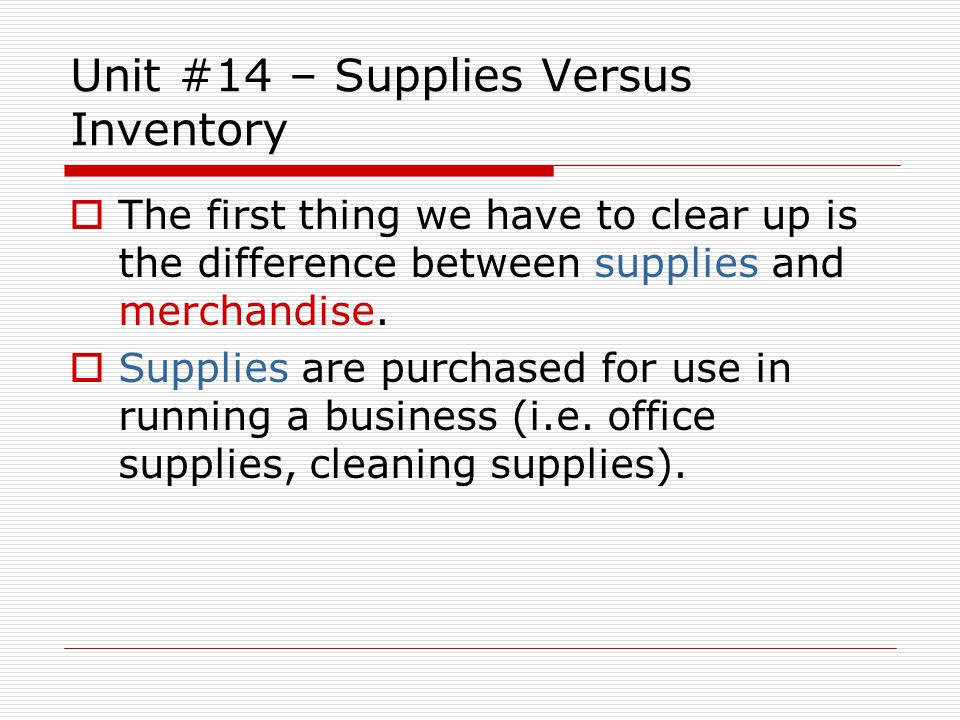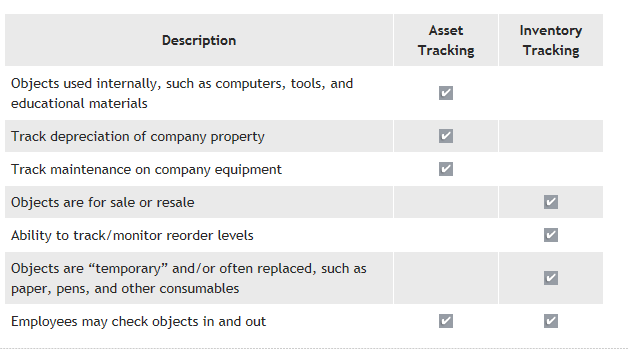Op 9 mo. Is that supply is to provide something to make something available for use while inventory is operations to take stock of the resources or items on hand.

Supplies Inventory Bookkeeping Simplified
The general ledger account Purchases is used to record the purchases of inventory items under the periodic inventory systemUnder the periodic system the account Inventory will have no entries until it is adjusted at the end of the accounting year so.

. I would say your fabric sample cards are also included in this category. As nouns the difference between supply and inventory is that supply is uncountable the act of supplying while inventory is operations the stock of an item on hand at a particular location or. It helps companies buy the right amount of widgets and then determines how often and when to reorder.
Office supplies paper towels and cleaning materials are all examples of supplies. Supplies on the other hand are not purchased with the intention of them being sold they are purchased for use within the business. Is there a difference between the accounts Purchases and Inventory.
Although the definition of stock is concise there are four main types of inventory. Inventory on the other hand refers to the raw materials that will be transformed into finished goods as well as the finished goods that will be sold to the end customer. They are purchased to assist in the day-to-day operations of the company.
As nouns the difference between supply and inventory is that supply is uncountable the act of supplying while inventory is operations the stock of an item on hand at a particular location or. Thread If you think your material is a supply it should generally be tracked as an expense rather than a material. The inventory manager will concentrate on his local stocks and place orders to suppliers taking into account supplier leadtimes and tariffs.
These leadtimes are a substitute for supplier capacity constraints. The supply chain manager will manage flows and inventory taking into account all sort of capacity and productivity issues along the way. Inventory is what you resell to a customer thus exempt from sales tax.
Its important that you classify supplies and inventory correctly because their classification has tax implications. Purchases Account Under the Periodic Inventory System. Differences Between Inventory Management and Asset Management.
It is important to keep an inventory of supplies that is to track and record what supplies were purchased and when for two reasons. Supplies that are not included in your cost of goods sold are items that are used multiple times even if they are used to produce your inventory. There are several differences between the two inventory systems and well look at the advantages and disadvantages below.
As with inventory you still need to keep track of how youre using your supplies how much you have left and when you should replenish supply levels. B Materials used in the production of your products that are not able to be inventoried due to an inability to accurately measure the material eg. The following table shows the difference between the two disciplines.
Asset management analyzes how a company uses items it owns that it does not intend to sell. Supplies are items that you use to support your day-to-day operations. One may also ask what account is supplies.
What exactly are supplies. A related account is Supplies Expense which appears on the income statement. Stock items are the goods you sell to customers.
Your business has to pay sales tax on supplies but you dont have to pay sales. In our restaurant we pay sales tax on trash liners mops brooms cleaning chemicals soap sanitizers as well as office supplies and receipt paper. A Materials not used directly in the manufacture of your products eg.
Examples of inventory items include office supplies such as paper and pens perishables of any kind and items that are used only once such as bandages or disposable air filters. Inventory These items do not need to be tracked closely like equipment but knowing the quantity on hand is valuable to an organization so that they can be reordered when necessary. PAR inventory relies on an occasional physical count of the inventory to determine the ending inventory balance and the cost of goods sold while the perpetual inventory system keeps continual track of inventory balances.
Differnce Logistics Inventory Management Logistic Management Logistics management plans implements and controls the efficient effective forward and reverse flow and storage of goods services and related information between the point of origin and the point of consumption in order to meet customer legal requirements. Needles are a good example here. Supplies are ultimately a cost to your business while inventory is generally sold to make a profit.
Keeping a supply inventory. If however you choose to keep an inventory you generally must use an accrual method of accounting and value the inventory each year to determine. The term inventory is used to refer to items which are held by the business for the purposes of resale in order to make a profit.
Patterns are also a good example of a supply expense. Supplies are the items a company uses to run its business and drive revenue whereas inventory refers to items the business has made or purchased to sell to customers. A current asset representing the cost of supplies on hand at a point in time.
Office Supplies Consumed are categorized as an expense. First it gives you visibility into supply. The account is usually listed on the balance sheet after the Inventory account.
Inventory management tracks parts products and supplies as a company buys sells or consumes them. Keeping levels of inventory on hand. The difference between inventory and stock is a subtle but important one.
Supplies is what is used within a business and subject to sales tax. Difference Between Inventory and Supplies The term inventory is used to refer to items which are held by the business for the purposes of resale in order to make a profit. Inventory includes the products you sell as well as the materials and equipment needed to make them.
Supplies are purchased for the use of your business. Method of accounting for inventory treats inventory as non-incidental material or supplies or conforms to your financial accounting treatment of inventories. To produce an inventory.
Supply planning determines how best to fulfill the requirements created from the demand plan. Raw materials work in progress MRO supplies and finished goods.

Difference Between Supplies Inventory Blog For Accounting Treatment
![]()
How Are Asset Tracking And Inventory Tracking Different Asset Infinity

Unit 14 The Merchandising Company Ppt Video Online Download

The A Team Consulting What S The Difference Inventory Vs Supplies Inventory Would Include Items Or Equipment Used To Make Your Goods And Sell Them Supplies Are Things Used To

Stock Vs Inventory Top 6 Useful Differences With Infographics

Asset Inventory Management Quality Digest
Difference Between Inventory Management And Inventory Control Difference Between

Deciding Between A Fixed Asset Or An Inventory Management System
0 comments
Post a Comment